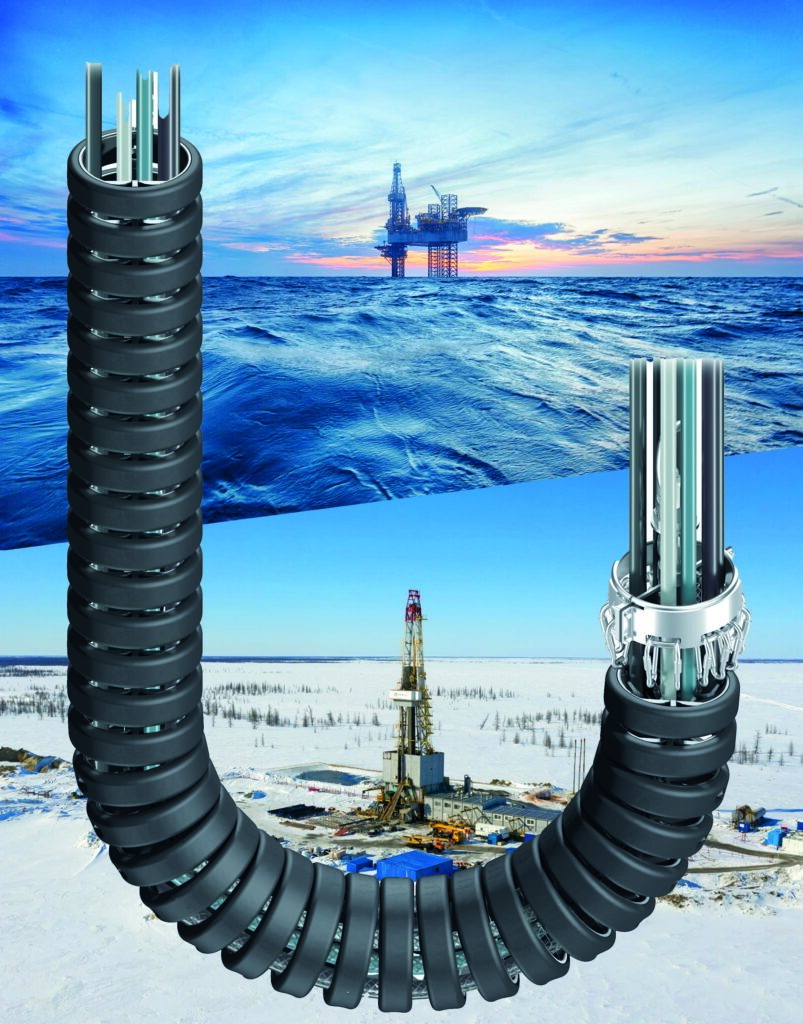The perfect loop for offshore operations
19/08/2024

The innovative igus e-loop can now easily allow a single damaged cable to be changed in the top drive of a jack-up rig in offshore oil & gas operations.
When a cable is damaged in the top drive system of a jack-up rig, normally the entire “service loop” with all cables and hoses must be removed. The igus® e-loop makes this laborious service task redundant: single cables can easily be exchanged. This has recently been proven in the field by specialised service company Energy Oil Solutions (EOS) in Esbjerg, Denmark.
Often when one cable in the “service loops” of jack-up rigs and platforms must be exchanged, it becomes an all or nothing decision. The loop supplies energy, signals, and hydraulic fluids from the “top drive”, at the mast of the actual drilling rig, to the moving powerhead which performs the drilling.
These service loops are wrapped and packaged cable assemblies suspended from a fixed point of the drill rig. As they have no guide and no defined bending radius, they move freely in the mast. Furthermore, they are constantly exposed to salt water and the weather, including hurricane force winds. Consequently, the cable package is likely to hit the mast during vertical movement and can snag there.
A cable loop weighing several tons, operating in adverse conditions
In addition, the system is already subjected to heavy stresses by the loop’s normal movement: each time a new module of the drill pipe is fed, the service loop – weighing several tonnes – travels the entire vertical distance of 30 metres or more. It is also subject to vibrations, impact and shock loads.
A clever alternative to the service loop
These different stresses mean that service loops serving these jack-up rigs need to be replaced relatively frequently. But now there is an alternative with a longer service life: the igus® e-loop. This cable guiding system has the advantages of both an energy chain and a high-strength fibre rope. Inside the chain, the rope transfers the pull forces to the mounting brackets and the structure. As a result, cables that are mounted and fixed at the mounting brackets incur little to no pull strain.
The inside of the e-loop consists of four injection-moulded parts. Two of them form the crossbar in the chain link and are mechanically fixed, clamping onto the rope. External protectors made of impact-absorbing PU material ensure that the energy chain and the cables are protected against heavy impacts.
Clever design takes the strain
The individual chain links are clamped onto the high strength pull rope in the centre of the loop. The rope is a plastic-fibre rope with a rated tensile load of 50kN, although in practice it can take much higher loads, and absorbs the entire tensile force of the e-loop. The mounting brackets are made of high strength steel. The e-loop’s design prevents the moving chain from hanging at the fixed ends bearing the entire assembly weight – the weight is transferred to the inner rope instead. These qualities make the e-loop the perfect service loop for offshore operations.
Several owners of jack-up rigs – mostly highly-specialised rental companies – have discovered the advantages of the e-loop and have installed them in their rigs. Two important features stand out: the longer service life and the simplicity of exchanging single cables when necessary.
A task but no longer a challenge: Exchanging a cable
The first use case of a cable exchange came two years after the introduction of the e-loop. A Europe-wide operating contractor had equipped its first jack-up rig with an e-loop at the beginning of 2022 in Amsterdam. About 18-months later, in a different rig located in the Danish region of Skagen, a wrong cable had been mounted in the loop. This cable had to be exchanged during an intermediate service at Esbjerg/ Denmark.
Justin Leonard, director of e-chains and cable products, igus® UK, says: “The complete loop contains 35-metre-long cables – 24 of them, as well as five hydraulic hoses, with a complete weight of more than 3.5 tonnes. The defective cable was one of the bigger ones with a cross-section of 300mm2 and weighing about 120kg alone. “
Offshore technology specialist EOS swaps the cable
The Esbjerg-based company Energy Oil Solutions (EOS) was commissioned to exchange the cable. Henrik Larsen, Electrical Supervisor of EOS, says: “We were delighted that an exchange of the complete service loop was not necessary. And we found that, with the support of igus®, it was very easy to remove the damaged cable and install the new one. “
EOS staff opened several e-loop compartments at the bottom of the loop. They disengaged the two cable connections of the broken cable at the mounting brackets and then easily pulled out the cable. Installing the new one was slightly more demanding. Henrik Larsen: “We used Chinese fingers to ´thread´ the cable into the loop, pull it up and connect it – a process that did not take much time or effort. “
Conclusion: a service-friendly, time-saving and sustainable solution
The entire repair took place within a few hours instead of several days. Due to the reduced weight in comparison to the formerly used service loop, no cranes were necessary. Sustainability was also addressed, as this solution saved carbon. Just one out of 29 cables and hoses had to be exchanged. Also, the service life of an e-loop is, in general, much longer than the lifetime of a service loop. And preventing further damage is also easy, says Henrik Larsen. “The jack-up rig operator suggested that a repair kit could be held in store for his rigs in Skagen. We will do this, and igus is in the process of producing it. “
For more information on this product, please contact:
Taylor Macdonald
Tel: 01604 677240
Email: tmacdonald@igus.net
